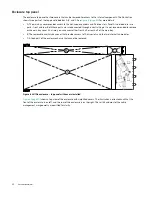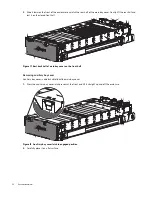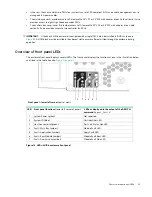
12
Safety guidelines
Electrical safety
•
The enclosure must only be operated from a power supply input voltage range of 200–240 VAC, 50/60Hz.
•
Provide a suitable power source with electrical overload protection to meet the requirements in the technical
specification.
•
The power cord must have a safe electrical earth connection. Check the connection to earth of the enclosure before
you switch on the power supply.
•
The system requires voltages within minimum fluctuation. The customer-supplied facilities’ voltage must maintain a
voltage with not more than ± 5 percent fluctuation. The customer facilities must also provide suitable surge
protection.
IMPORTANT:
The enclosure must be grounded before applying power.
•
The plug on the power supply cord is used as the main disconnect device. Ensure that the socket outlets are located
near the equipment and are easily accessible.
•
4U106 enclosures are intended to operate with two PSUs, four system fans accessed from the rear panel, and two
controller channel fan modules which can be accessed from the top of the enclosure.
•
Observe the power-supply disconnection caution label affixed to PSU modules.
CAUTION:
Do not remove covers from the PSU or any other FRU module. There is a danger of electric shock inside.
Return the plug-in module to your supplier for repair.
IMPORTANT:
The RJ-45 socket on IOMs (Input Output module) is for the Ethernet connection only and must not be
connected to a telecommunications network.
•
Exos E 4U106 storage enclosures are suitable for connection to intra-building or non-exposed wiring or cabling only.
•
Exos E 4U106 storage enclosures are suitable for installation in locations where the NEC (National Electrical Code)
applies. These enclosures are not suitable for Outside Plant (OSP) installations.
Rack system safety precautions
The following safety requirements must be considered before mounting the enclosure in a rack.
•
Before installing a 4U106 enclosure into the rack, see the
CAUTION
on
and the
WARNING
.
•
The rack construction must be capable of supporting the total weight of the installed enclosures. The design should
incorporate stabilizing features suitable to prevent the rack from tipping or being pushed over during installation or
in normal use.
•
When loading a rack with enclosures, fill the rack from the bottom up. Empty the rack from the top down. Heavier
enclosures should be located beneath lighter enclosures for optimal stability.
•
One person alone should not try to lift the enclosure.













































